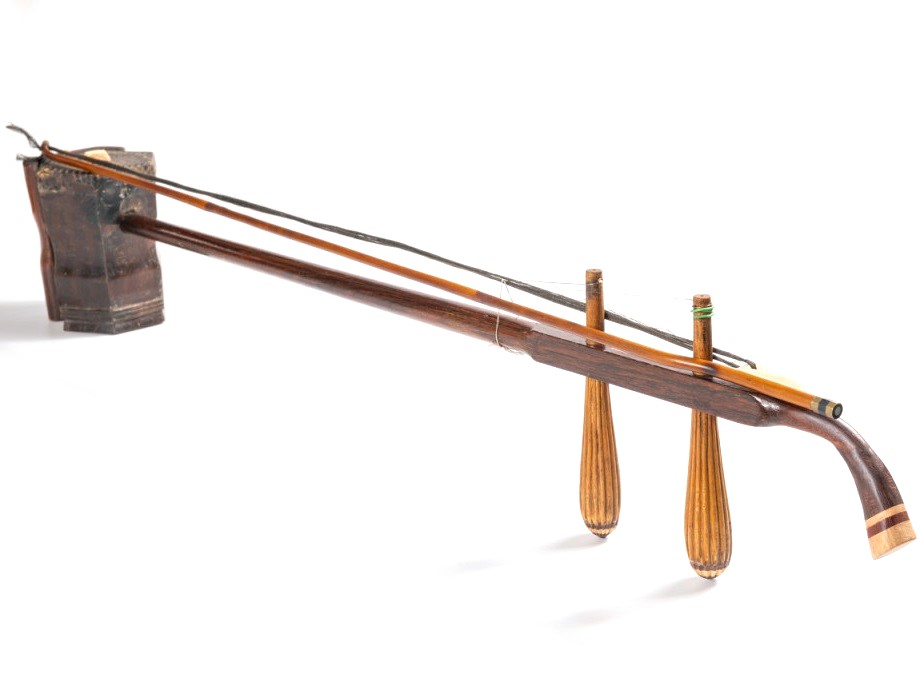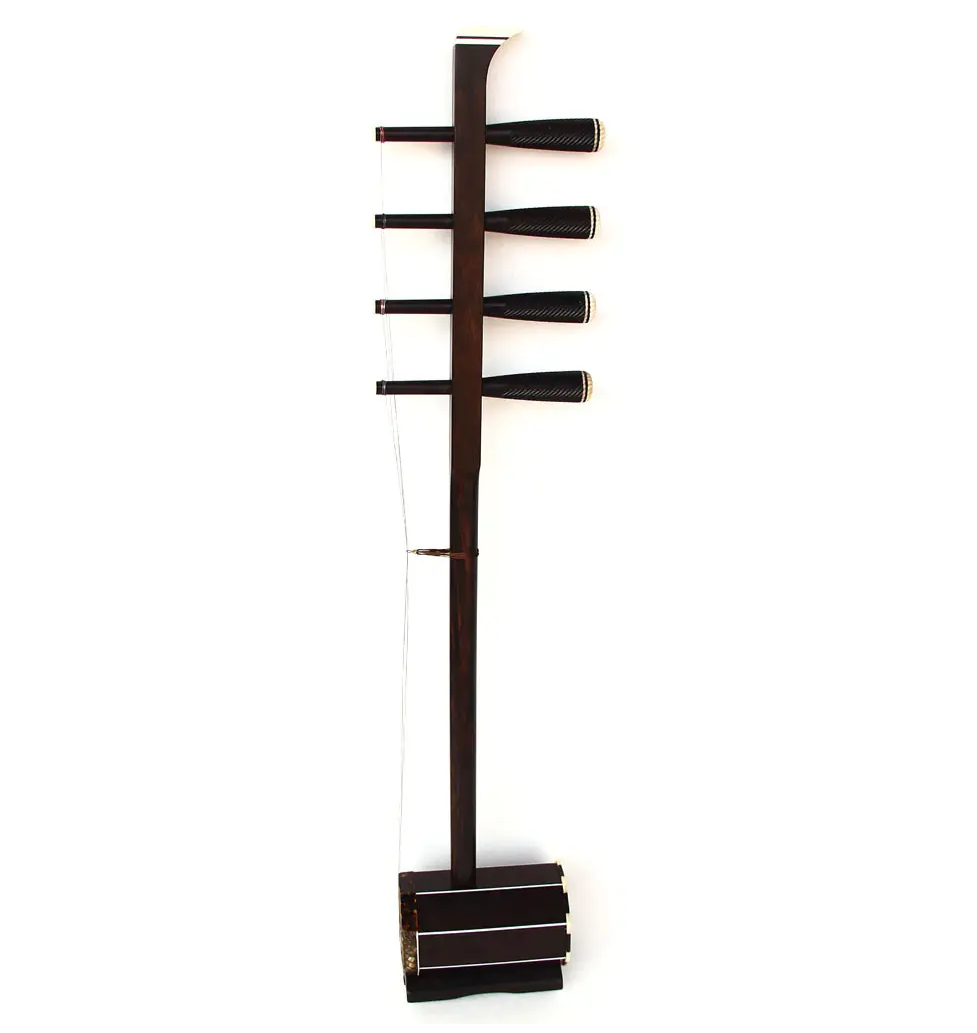Sihu (China)
Bowed Instruments
Asia
Between 1001 and 1900 AD
Video
The Sihu (四胡) is a bowed string instrument originating from China. It is part of the huqin (胡琴) family, which consists of various traditional Chinese bowed instruments. The name “sihu” translates to “four-stringed huqin,” distinguishing it from other two-stringed variations such as the erhu.
The instrument features four strings arranged in pairs and is played with a bow, producing a rich, warm tone that blends well with traditional ensembles and solo performances. The sihu belongs to the bowed string instrument category, similar to the erhu, gaohu, and zhonghu. It is classified as a chordophone, meaning sound is produced by vibrating strings. It is commonly used in regional operatic music, folk ensembles, and storytelling performances.
History
The sihu has a long history in China, dating back to the Yuan Dynasty (1271–1368). It is believed to have originated from the Inner Mongolia region and gradually spread to various provinces. The instrument became an integral part of Mongolian and northern Chinese music, playing a significant role in storytelling traditions such as “Shuoshu” (talking and singing performances).
During the Ming (1368–1644) and Qing (1644–1912) Dynasties, the sihu saw extensive use in opera, folk music, and court performances. While it is less common today than the erhu, it remains important in regional Chinese music traditions, particularly in Shanxi, Inner Mongolia, and Hebei.
Construction: Materials Used
The sihu is crafted using a combination of wood, metal, and animal-derived materials. The main components include:
Soundbox: Typically made from hardwood such as rosewood or sandalwood. Some versions feature a coconut shell body, enhancing the tone’s resonance.
Strings: Traditionally made from silk, though modern sihus use steel-wound or nylon strings for durability.
Neck: Carved from bamboo or hardwood, extending upward from the resonator.
Bridge: Usually crafted from wood or bone, supporting the strings and transferring vibrations to the soundbox.
Bow: Made from horsehair and wood, strung between the strings like other huqin family instruments.
Types of Sihu
The sihu has various regional variations differing in size, tuning, and tonal characteristics. The main types include:
Alto Sihu: The most common type, used in opera and folk ensembles.
Bass Sihu: A larger version with deeper tones, used in Mongolian music.
Soprano Sihu: A smaller, higher-pitched variant used for delicate melodic lines.
Folk Sihu: Regional variations used in storytelling and local operatic traditions.
Characteristics
It produces a mellow and full-bodied sound, suitable for both melancholic and lively melodies. Different sizes exist, accommodating various musical contexts. The bow is permanently positioned between the strings, allowing smooth, continuous playing. Typically tuned in perfect fifths or fourths, depending on regional styles. Includes techniques like vibrato, glissando, and trills.
Sound Production
Sound is produced by drawing the bow across the strings, causing them to vibrate. The resonator amplifies the sound, which is then projected outward. The construction of the soundbox and the materials used significantly influence the timbre. The presence of paired strings allows for a harmonic, layered tone, different from the erhu’s single-string sound.
Playing Methods
The sihu is played with a bowing technique similar to that of the erhu but requires additional precision due to its paired strings. Common playing techniques include:
- Legato Bowing: Smooth, connected bow strokes for lyrical passages.
- Staccato Bowing: Short, accented notes for rhythmic emphasis.
- Double Stops: Playing two strings simultaneously for a fuller sound.
- Glissando: Sliding between pitches for an expressive effect.
- Ornamentation: Quick trills and finger vibrato to enhance musicality.
Role in Music
The sihu has been used in various musical genres, including:
- Chinese Opera: Provides accompaniment for traditional opera performances, particularly in Shanxi opera and Hebei bangzi.
- Folk Ensembles: Often featured in Mongolian and northern Chinese folk music.
- Storytelling: Used in narrative singing traditions such as “Shuoshu”.
- Modern Adaptations: Occasionally incorporated into contemporary Chinese orchestras.
Cultural Significance
The sihu is deeply embedded in Chinese musical traditions, especially in Mongolian and northern Chinese culture. It is considered a symbol of cultural heritage, representing the artistry of folk musicians and opera performers.
In Inner Mongolia, the sihu is used in pastoral songs and ceremonial music, contributing to the preservation of Mongolian identity. In Shanxi and Hebei, it remains a key instrument in local operatic styles, linking modern performers with centuries-old traditions.
The sihu is a historically rich and sonically unique instrument that continues to hold cultural value in China. Though overshadowed by the erhu in mainstream Chinese music, it remains vital in regional folk traditions, opera, and storytelling performances. The sihu’s warm, expressive tone and unique four-stringed construction make it an essential component of China’s musical heritage. Its role in preserving traditional music and its adaptation in contemporary performances ensure its legacy endures for future generations.
FAQ
How does the Sihu produce sound?
The Sihu produces sound through bowing its four strings with a horsehair bow. The strings vibrate, transmitting sound to the resonator, which amplifies it. The wooden body and skin membrane contribute to its rich, warm tone. Different bowing techniques affect timbre and dynamics.
What role does the Sihu play in Chinese music?
The Sihu is commonly used in Mongolian and northern Chinese folk music. It often accompanies storytelling, opera, and traditional ensembles. Its expressive tone makes it ideal for lyrical and dramatic passages. Variants of the Sihu are also found in different Chinese ethnic traditions.
How is the Sihu used in musical compositions?
Sihu compositions often feature expressive glides and ornamentations. It is played in unison with other bowed instruments or as a solo voice in folk music. Composers write for Sihu in both traditional and contemporary styles. Modern adaptations explore its potential in fusion genres.
 Links
Links
References
Other Instrument
Categories



















